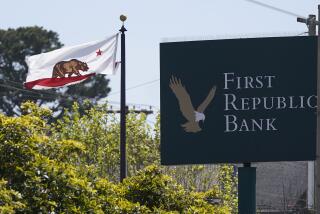a plan to end big bank bailouts
WASHINGTON — The cost of future government rescues of huge financial institutions would be paid by their surviving rivals while the troubled firms’ management would be fired, their unsecured creditors would face losses and their shareholders could be wiped out, according to a proposal released Tuesday by the Obama administration and a key House panel chairman.
The legislation tries to address the issue of large bank holding companies and other complex financial firms, such as American International Group Inc., that have been deemed “too big to fail” because of the damaging effect that a bankruptcy filing by one of them could have on the overall economy.
The proposal would seek, in effect, to allow such firms to fail but in a controlled manner that would minimize the collateral damage -- and not leave the government with the tab.
The legislation would “ensure that the industry and shareholders absorb the risk and cost of failure, not taxpayers,” according to a statement released late Tuesday along with the legislation by the Treasury Department and Rep. Barney Frank (D-Mass.), chairman of the House Financial Services Committee.
By putting a financial firm’s shareholders, creditors and executives at risk, the legislation also is designed to discourage companies from taking excessive risks and from becoming too large in the first place.
Such incentives could diminish the concern expressed by many economists and government officials that last fall’s bailouts had set a precedent for the government to bail out “too big to fail” firms with taxpayer money, creating a “moral hazard” and encouraging them to engage in risky behavior.
The 258-page bill, which also would provide for increased oversight of the economy to look for signs of “systemic risk,” is a major component of the Obama administration’s proposed sweeping overhaul of financial regulations, which is working its way through Congress.
Scott Talbott, a lobbyist for the Financial Services Roundtable, which represents about 90 large financial firms, said it had concerns about some provisions in the bill but supported its overall goals, including the idea of assessing firms to pay for the failure of rivals.
“There are plenty of instances of asking the industry to cover the costs of others,” Talbott said.
Treasury Secretary Timothy F. Geithner has said that the Federal Reserve had to take over AIG, and federal officials had to help prop up banking giants such as Citigroup Inc. and Bank of America Corp., because there is no orderly process for seizing them and selling them off. Geithner will testify about the new plan before Frank’s committee Thursday.
Under current law, the Federal Deposit Insurance Corp. seizes troubled banks, sells their assets and insures deposits of up to $250,000 per account in most cases with a fund paid for by assessments on all banks. But there is no similar mechanism for huge, complex financial institutions, including companies that own investment arms and other businesses as well as banks.
Under the proposed legislation, such firms in danger of failing also would be taken over by the FDIC. Management would be removed, unsecured creditors would have to take unspecified losses and shareholders would not be paid until all other claims were settled.
The company’s assets would be sold, but if the proceeds didn’t cover the money spent by the government to pay off claims, financial institutions with total assets of at least $10 billion each would be required to pay into a fund that would reimburse the government. There are about 120 firms with at least that amount of assets, Talbott said.
The proposal mirrors suggestions made by Elizabeth Warren, head of a congressional panel that monitors the $700-billion Troubled Asset Relief Program, or TARP.
“We need a system that spells out the high prices that would be imposed if any company ever calls on the government for help,” she said Tuesday before the legislation was released.
“If the price of government support is that the equity is wiped out, the debt holders take a haircut and the management team is replaced, moral hazard evaporates,” Warren said. “The people running big companies will not gamble with company assets in a way that makes taxpayer support the first option when something goes wrong. They will run their companies in a way that prevents the need for taxpayer bailouts.”
It’s unclear how many firms would be considered big enough under the proposal to be dismantled under its provisions. In the spring, the government in effect treated the 19 U.S. bank holding companies with more than $100 billion in assets as too big to fail, putting them through special “stress tests” to determine whether they needed further infusions of capital from the government.
The measure is unlikely to satisfy lawmakers, including Republicans and some Democrats, who have opposed provisions in it that would grant the Treasury Department power to put up unlimited amounts of taxpayer money to seize and dismantle giant financial institutions -- a power these opponents have called “permanent bailout authority.”
The TARP fund, on the other hand, will expire by late 2010.
Rep. Brad Sherman (D-Sherman Oaks), who has criticized attempts by the administration to cut Congress out of any future bailout decisions, challenged the assertion that the proposal released Tuesday follows a “polluter pays” model.
“It’s not the polluter that pays. It’s the entities that were clean and had to compete with the polluter,” Sherman said. He said he would prefer a fund that large firms pay into in advance, just like the FDIC’s Deposit Insurance Fund.
More preferable, Sherman said, would be a prohibition on financial institutions whose liabilities are greater than $120 billion or 1% of the country’s annual economic output. If a government bailout is required, it should be approved by Congress, as the $700-billion TARP fund was, he said.
--
More to Read
Inside the business of entertainment
The Wide Shot brings you news, analysis and insights on everything from streaming wars to production — and what it all means for the future.
You may occasionally receive promotional content from the Los Angeles Times.











